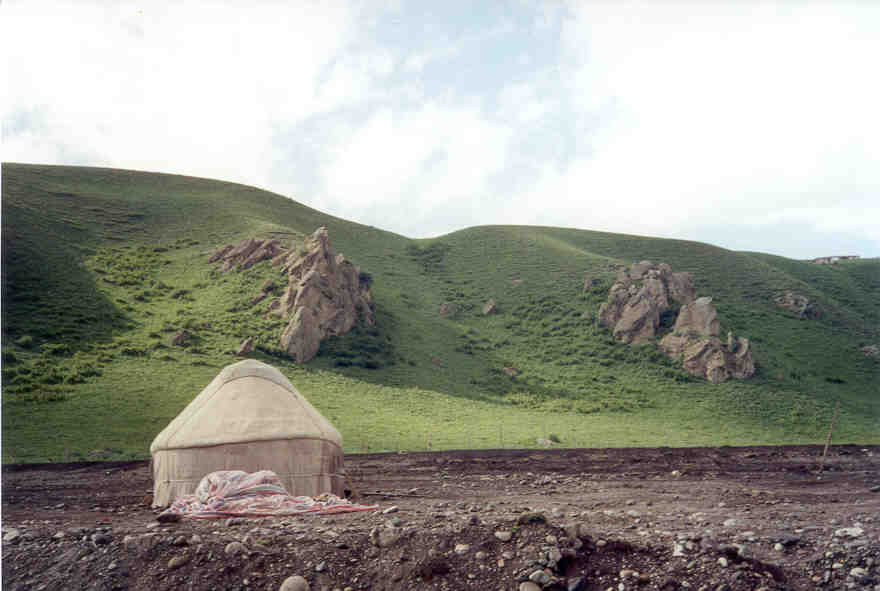One strength of the English language has been its incredible ability to assimilate any noun from any language–and then, through mispronunciation, claim it for itself. This characteristic is undisputably useful, but can also institutionalize translation errors. The yurt is not a yurt. Yurt means “homeland”. Wikipedia says:
In Kazakh (and Uyghur) the term for the structure is kiyiz uy (úøіÃ· үù‚ lit. “felt home”). In Kyrgyz the term is “boz ui”, literally “grey house”, because of the colour of the felt. In Mongolian it is called a ger (óÑÂÂÑ€). Afghans and Pakistanis call them “Kherga”/”Jirga” or “ooee”. In Pakistan “Ú¯ÛÂÂر”.
 Central Asian nomads have built felt homes in order to move with the herding season since approximately the fifth century B.C. A wood frame composed of long pieces and collapsible trellis provide the skeleton, which is covered in felt and then roped down with a functional, attractive interweaving. According to Jacqueline Ruyak, (see Worth Reading: Kyrgyzstan), grey yurts are for everyday; white ones for ceremonial purposes such as weddings. Wood is the scarce material on the steppes, but the felt-making must be the most labor-intensive part of basic construction.
Central Asian nomads have built felt homes in order to move with the herding season since approximately the fifth century B.C. A wood frame composed of long pieces and collapsible trellis provide the skeleton, which is covered in felt and then roped down with a functional, attractive interweaving. According to Jacqueline Ruyak, (see Worth Reading: Kyrgyzstan), grey yurts are for everyday; white ones for ceremonial purposes such as weddings. Wood is the scarce material on the steppes, but the felt-making must be the most labor-intensive part of basic construction.
 In 1997, the Mingei International (Folk Arts & Design) Museum of San Diego exhibited a prize-winning Kyrgyz ceremonial felt home that the Osmonaliyev family took five and a half years to complete. The latticework was bound by red wool woven onto the lattice; so too were the room dividers decorated by interwoven red yarn. The felt was embroidered. There were no pictures of this museum-quality dwelling, so I have found these others that might convey a little of the beauty and functionality of this kind of building. And just watch this [fabulous!] video by Rebecca Schultz, with lovely music (so turn up your sound). I think Ms. Schultz also conveyed some of the strength of the family depicted, as they erected this ceremonial boz ui.
In 1997, the Mingei International (Folk Arts & Design) Museum of San Diego exhibited a prize-winning Kyrgyz ceremonial felt home that the Osmonaliyev family took five and a half years to complete. The latticework was bound by red wool woven onto the lattice; so too were the room dividers decorated by interwoven red yarn. The felt was embroidered. There were no pictures of this museum-quality dwelling, so I have found these others that might convey a little of the beauty and functionality of this kind of building. And just watch this [fabulous!] video by Rebecca Schultz, with lovely music (so turn up your sound). I think Ms. Schultz also conveyed some of the strength of the family depicted, as they erected this ceremonial boz ui.
Photos: RogerWendell.com; Chebucto.org
Ulantaaj has a history page for further reading